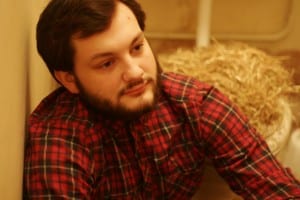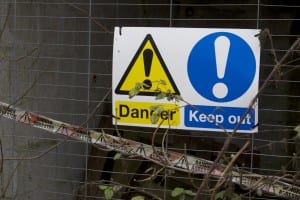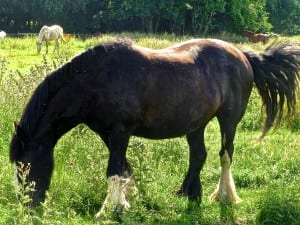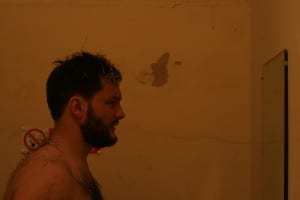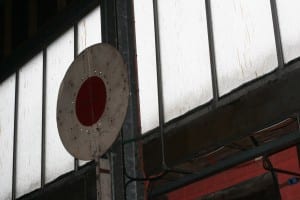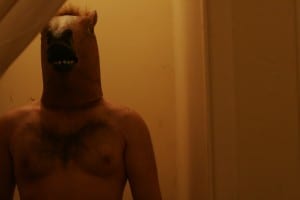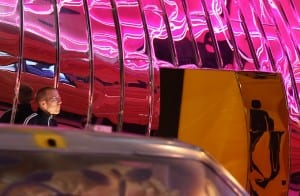The Human Beginning (Framing Statement)
Human Regression: The Saddle on my Back was the title of my devised performance using the Lincoln grandstand as a site of which to create this piece of site specific performance. I performed on the 8th of May 2014 at the Lincoln grandstand from the hours of 2pm-5pm, throughout these three hours I had performed a 10 minute piece over and over again, I had covered myself in mud and hay, I had been in a close intimate space with my audience as I lock them in a cubicle with myself as I begin my narrative and then I exit maintaining eye contact with the audience and look at them through a mirror. I transformed into my horse with the narrative I had created and finally led them to the cubicle next door with myself fully nude, showing them myself in a stable created in that cubicle with lots of hay and a horse mask.
Development was a key part of my process, as it is in all devised pieces, however, what was key was the paradox of performance and concept, I had originally begun with the concept of decay, I had decided to represent the decay the grandstand had undergone “It foresees and prescribes what will happen without necessarily settling how” (Pearson, 2010, 149) This allowed me to play with so many different varieties of performance including, installation art, live art and one to one performance. However, once I had reached the conclusion of the one to one performance the performance began to have an effect on the concept, I began to see the concept develop as the performance developed “Performance may equally impose a concept on site, their relationship in congruent or paradoxical, including orders of material unusual…Despite their apparent dissimilarities, they begin to bleed into one another.” (Pearson, 2010, 149) My performance allowed me the idea of transformation, becoming a horse, the most relevant animal to the grandstand. It led me to displaying the decay of horses and how a human can decay into a horse, a mental and physical transformation.
The audience were part of my process, they were my influence, I wanted them to see what I could see, I wanted them to sympathise and free their minds to see the decay surrounding them. I locked them in a toilet cubicle with me, stared them in the eyes and never lost that contact because I wanted them to take this journey with me:
“The Host site is haunted for a brief time by a Ghost that the theatre makers create. Like all ghosts, it is transparent and Host can be seen through Ghost. Add into this a third term – the Witness – ie the audience, and we have a kind of Trinity that constitutes the Work… All three are active components in the bid to make site–specific work.” (McLucas, 2000, 128)
The ‘Trinity’ is a key idea to Site Specific and particularly mine; it is a unity of the three members the audience member, myself and more importantly the grandstand.
Embodying the Narrative (Process)
For many of us initial research was developed with the use of Mike Pearson’s Site-Specific Performance and the guide to first encountering a site “What are my objectives? How is my visit planned in advance?… How do I orientate myself? Do I seek out the traces.” (Pearson, 2010, 21) In focusing on the idea of objectives I thought about how I encounter the space, I walked around the outside and measured the length of the grandstand, it came to 23 Adam spans, an entirely made up unit of measurement but one that I felt helped me define myself around the grandstand. As a group we had objectives, one was to find something that looked out of place in the grandstand and so a variety of litter was found. I believe this was one of the initial starting points for my concept as it was the first sign of decay and as you encounter one sign you begin to encounter so many. I spent most of the session finding this decay and documenting it such as the fact that the windows at the back of the grandstand are not actually windows but rather painted on images to create an illusion. This concept of covering up what was decaying also began to cross my mind with the paint and the no entry stables possibly because the council do not want the public to see the grandstand in this state.
The next session was discovering spaces within the grandstand, again as a group we looked at a wider variety of methods but the one that particularly stood out was the concept of drifting in Smith’s Mythogeography and how it allows us discover the site in a more intimate style. Many steps stood out such as the use of smells and senses yet one concept stood out to me most of all initially because I could not understand it, the derive. Smith refers to simply in his first step and does not explain it in great detail “Rites of passage…The derive lops off the last three and short-circuits flux straight back into separation.” (Smith, 2010, 118) Although, when he used the concept of rite of passage I saw it through the eyes of a religious ceremony such as Baptism or a Bah mitzvah this allowed me to understand that it was simply the beginning of a journey without an end, as one of my blog posts is entitled “An A With No B”(Robinson, 2014) This concept of not knowing where you are going seemed baffling at first yet seemed to reflect life itself when you first encounter anything new and complex:
“In a dérive one or more persons during a certain period drop their relations, their work and leisure activities, and all their other usual motives for movement and action, and let themselves be drawn by the attractions of the terrain and the encounters they find there.” (Debord, 1958)
I allowed myself to do this in various rooms within the grandstand in particular a room with RFC emblem painted above a mantel (Later research states this was a training room for the RFC) it led me to a corridor with doors that could not be opened and walls that had holes in them and began to crumble, this is where I had been lead, with a clear head I had been taken to through drifting to a small place with a unique smell but still a sense of decay.
![Robinson, A. (2014) [Image online] Available from https://sitespecific2014mpi.blogs.lincoln.ac.uk/2014/02/13/an-a-with-no-b/ [Accessed 12th May 2014].](https://sitespecific2014mpi.blogs.lincoln.ac.uk/files/2014/02/MG_7829-200x300.jpg)
Robinson, A. (2014) [Image online] Available from https://sitespecific2014mpi.blogs.lincoln.ac.uk/2014/02/13/an-a-with-no-b/ [Accessed 12th May 2014].
I entitled the video ‘What use to be’ and presented it in the space on the cubicle seat using only the dim natural light of the blocked out skyline windows. This proved to me to be a huge leap in the understanding of Site Specific performance and that it is not about acting it is about representing the site in a way that is not usually perceived “Site-specific performance… reveals the complex two-way relationship between the person and the physical environment.” (Harrison, 2010) This is the main creation I have made, fusing people with the physical environment with the atmosphere of the space and the documentation showing what may have been missed.
When I presented the installation I had created in the toilet cubicles I realised a flaw that existed and that was the size of the space, too many people were trying to get in one tiny space. As I explored this difficulty I came to the realisation that people would have to enter the space one at a time, this led to me to doing research into the idea of one to one performance “One to One performance… affords the spectator to immerse themselves in the performance framework set out by the practitioner. This can be a seductive / scary / liberating / boring / intimate prospect and an even more intensive experience.” (Zerihan et al, 2009) However, I didn’t want this performance to become something I act in, I want it to become something more and so I begun to look at types of site performance that could be fused with one to one performance and the concept of live art stood out “Performance, in fact, is now where it’s at; it’s hard to think of much recent art that isn’t, at some level, performative.” (Searle, 2012) Art and performance aren’t just a fusion, they are in fact one of the same thing. Further research into one to one performance helped me to understand what I wanted to undertake to a greater extent “One to One performance foregrounds subjective personal narratives that define – and seek to redefine – who we are, what we believe and how we act and re-act.” (Zerihan, 2006) This lead me to another realisation that it was enough to just display pictures but to give voice, my own voice and narrative I needed to research and create for the intimacy of this performance. I researched into practitioners and Martina Von Holn, used one quote in her interview that particularly stuck in my head with reference to her piece Seal of Confession “What is essentially occurring is a making oneself vulnerable, the unpredictability of the audience… is an expression of that ‘disarming’ process. The negotiation of trust through taking risk lies necessarily at the heart of the encounter.” (Von Holn and Searle, 2009) I wanted to explore this, the concept that one to one performance is also about exploring your own vulnerabilities as well as the sites. I looked back through my research and began to understand that for this performance I personally wanted to embody that decay, I wanted to represent the decay of the site through a platform that could be accessed by the performer and the audience. I watched the video I had created previously What use to be and a theme that continuously appeared was a horse, a decay in the stables the horses were kept in, a decay in the grandstand of which they would be weighed in and I realised that this needed to be incorporated into my performance.
Documentation, movement and time spent around horses seemed the most appropriate way to go about developing a horse into my performance, I went to local stables and fields found horses and decided that I should fulfil the criteria I had set. I created a lot of documentation focusing around these horses and concentrated on there limbs and movements and the different living conditions they can appear in.
For example at the site itself some of the stables were abandoned when I first saw them with wildlife growing around and inside them, these aren’t fit for a horse, once again they represented the decay. Yet, they also led me to an idea, creating a stable inside the cubicles, presenting the decay of one cubicle and the creation of a stable in the other.
With the induction of a dual cubicle concept I was marking out my space, I had begun to explore the endless possibilities I could develop and so began to reimagine the concept of a horse and human, I developed more research that took me in the path of interspecies performance. “The animal is the latest figure to be enlisted in the ongoing exploration of identity that has defined progressive politics in the past several decades.” (Chaudhuri, 2004, 39) I had already developed a keen connection with horses and interspecies performance offered me the idea of human and horse as a performer not just an area to be marked out. Animals were in fact a fantastic way to define a message you are trying to send “Animals – ‘trapped in a place of endless misrecognition’… often been defined in terms of lack: of reason, memory, imagination, free will, conscience, language, and so on.” (Williams, 2000, 30) I wanted to show the strength of the horse, how it deserves more from homosapien than it has received. I wanted to show human decay and how we cause the majesty of a horse to decay.
I began to look at performances surrounding the horse and stumbled across Chasing Canada by Kimber Sider in which she undertook a journey with her horse as one entity and made their way across Canada only by using the directions of people they happened upon. This fusion of Horse and human continued to inspire me in directions I never thought imaginable.
![Sider, K. (2008) [Image online] Available from: https://www.flickr.com/photos/ridecanadawest/2924886383/in/set-72157635063339660 [accessed on 29 March 2014]](https://sitespecific2014mpi.blogs.lincoln.ac.uk/files/2014/03/2924886383_df5720cb2b_z-300x225.jpg)
Sider, K. (2008) [Image online] Available from: https://www.flickr.com/photos/ridecanadawest/2924886383/in/set-72157635063339660 [accessed on 29 March 2014]
Horsie Talk Reported by Adam Robinson
This gave me material to work with; I decided against using this in the actual performance, however, it has led me to want to understand the history behind horses. I began research into myths and legends surrounding equestrians and the decay they have felt throughout the world “Mud fever…affects horses living or working in wet, muddy conditions. The skin over the pasterns and heels becomes infected, resulting in scabby or exudative lesions which can be very painful.” (Devereux, 2007) These facts and myths were the beginnings of my narrative and helped me to expand ideas into actually performing. I use the mud reference I found for my narrative as it influenced me to perform an action, it was the trigger to begin to cover myself in mud as it perfectly represented the decay of horses through mistreatment. The other actions also began to develop with how Celts saw the horse and how Arthurian legend depicted them. The idea of chalk horses being drawn in fields and that horses with chalk on them are lucky in racing circles lead me to the action of drawing on myself and the space in chalk. Yet, the performance that offered the largest input to mine was Horse in which the performer was preceding believeing that she was a horse, but she wasn’t the horse she thought she was. I wanted people to beleive I wanted to be a horse and I wanted to push myself as a performer and so I wanted to show regression and decay through the loss of my clothes.
All of this developed and expanded on a grander scale all leading up to the final rehearsal, I had littered my left cubicle with hay and left the right cubicle bare I had mud, chalk, hay and my mask. The last thing I had yet to do was to see if I could push myself as a performer to become naked, I asked a member of another group if they would be the respective audience member in my piece and they came in, I tied there wrist and it had all begun. This maybe one of the most peculiar experiences I have ever had due to the fact that once I had prepared myself and built up the courage to bring them in it was relatively easy. I had entered a focus, one I could not be disturbed on that allowed me to undergo this transformation I had been building up to, it came as second nature, as if I should always have been doing this. This is when I knew I was proud, the moment I had put off the longest was my shining glory, I had set a timer on a camera after to see the visual and even through a camera lens when I am tied to my stable the visual was something I could not have hoped would look better.
Becoming the Horse (Evaluation)
After performing at the Lincoln Grandstand on the 8th of May I have certainly encountered new experiences and developed as a performer, practitioner and human being. Audience members were regular and consistent; as soon as one had left another would be ready waiting at the door. The direction in the space worked well, when the audience were taken into the cubicle and locked in with me eye contact was maintained consistently, whilst it was hard to keep up I feel I did a good job and it served an essential role in creating the audience/performer relationship. I also feel the concept of eye contact maintained through the reflection of the mirror was fantastic as you never lose your audience, you always remind them of your presence and combined with the delivery of my narrative, that I did not rush through but rather took my time and enjoyed, the audience members seemed to be captivated.
In retrospect the items I put on my body (hay, mud, chalk etc..) went well, although, I feel I could have improved on this, I believed that I should have undergone more processes, such as horse-related consumption of one type or another. I also believe I could have had more hay on me, more mud smothered on my body, I believe I had the desired effect but I would have loved to really go over the top with this. Another improvement to be made would be the narrative, I wish instead of only removing my top when locked in the cubicle that I had created a narrative where I was entirely nude in the cubicle with the audience member. This does have its flaws in that it would make some audience members very uncomfortable but it would maintain that desired message that my clothes had decayed, humans had caused this decay, that direct eye contact when like that would have had a huge impact on the audience member.
If I were to create this performance again, I would want to spread it to a wider audience not just one to one, I would like to introduce more physical contact between the audience member and I such as allowing them to feed me, water me or pet me. I believe this would create a more definitive transformation from human to horse. I also would have used the decayed sinks more, I would like to have explored would I could have created in that space. Whilst it was a perfect representation of my whole piece I feel it needed something more just to create a more visual impact.
This process has taught me so much about myself and the varying degrees of performance and everyday life. It has taught me to appreciate the history of things you would normally seem irrelevant and it taught me that only when you are truly lost are you found.
Bibliography:
Performances Cited:
Leentje Van de Cruys: Horse (2010)
Kimber Sider: Chasing Canada (2008)
Martina Vol Holn: Seal of Confession (2007)
Publications Cited:
Bishop, C. (2005) But is it Installation Art? Tate Etc, 3 (Spring). [online] London: Tate. Available from http://www.tate.org.uk/context-comment/articles/it-installation-art [Accessed 5 March 2014].
Chaudhuri, Una. “Animal Acts for Changing Times: When Does the Non-human Become More than a Metaphor on Stage?” American Theater 21.8 (2004): 36-9.
Debord, G. (1958). Theory of the Derive (Debord). [online] Available at: http://www.bopsecrets.org/SI/2.derive.html [Accessed on 12 February 2014].
Devereux, S (2007) Mud fever: Recognise, treat and prevent it. Farmers Guardian [online] Available from: http://www.farmersguardian.com/home/equestrian/mud-fever-recognise-treat-and-prevent-it/6096.article [Accessed 25 April 2014].
Irish Museum of Modern Art (2012) What Is – Installation Art, Dublin: Irish Museum of Modern Art.
Harrison, B. (2010) Theatre Style: Site Specific Performance. [online] Scotland: Scottish Arts Council. Available from http://www.scottisharts.org.uk/1/artsinscotland/drama/features/archive/themesitespecifictheatre.aspx [Accessed 5 March 2014].
McLucas, C. (2000) Ten Feet and Three Quarters of an Inch of Theatre in Kaye, N. Site-Specific Art: Performance, Place and Documentation. London: Routledge, pp 125-137.
Pearson, M. (2010) Site-Specific Performance. Basingstoke: Palgrave Macmillan.
Robinson, A. (2014) An A With No B. [blog entry] 13 February 2014. Lincoln: University of Lincoln. Available from https://sitespecific2014mpi.blogs.lincoln.ac.uk/2014/02/13/an-a-with-no-b/ [Accessed on 14 May 2014].
Searle, A. (2012) How Performance Art Took Over. [online] London: The Guardian. Available from http://www.theguardian.com/artanddesign/2012/jul/03/performance-art-abramovic-tate-modern [Accessed 19 March 2014].
Smith. P. (2010). The Handbook Of Drifiting. Mythogeography : A Guide To Walking Sideways. 118- 121.
Williams, David. “The Right Horse, The Animal Eye – Bartabas and Théâtre Zingaro.” Performance Research 5.2 (2000): 29-40.
Zerihan, R., Ashery, O., B, F., Bartram, A., Dobkin, J., Freeman, D., Howells, A., Johnson, D., Kartsaki, E., Kela, L. Louise, B. Mendes-Silva, S. O’Reilly, K., Parthipan, J., Pinchbeck, M., Rose, S., Sweeting, S., Von Holn, M. (2009) Live Art Development Agency Study Room Guide on One to One Performance.
Zerihan, R. (2006) Intimate Inter-actions: Returning to the Body in One to One Performance. [online] Available from http://people.brunel.ac.uk/bst/vol0601/rachelzerihan/home.html [Accessed 19 March 2014].

